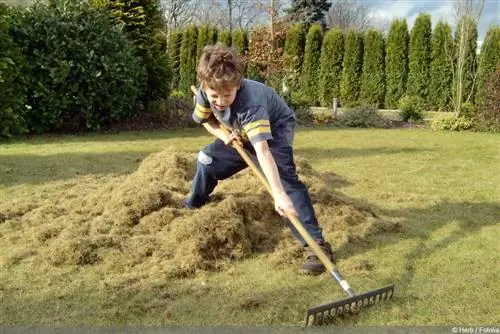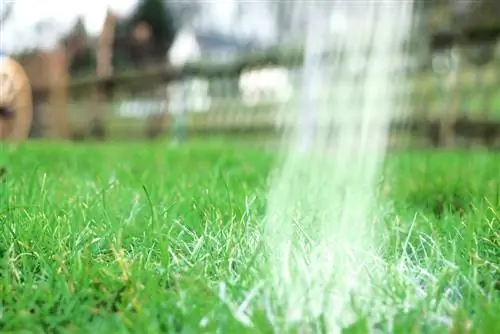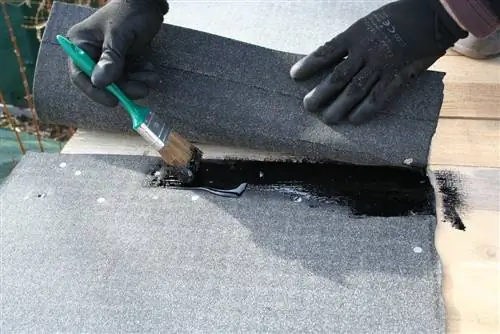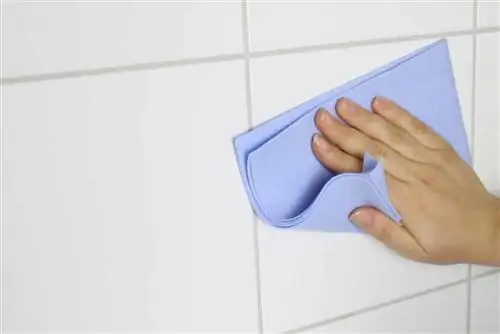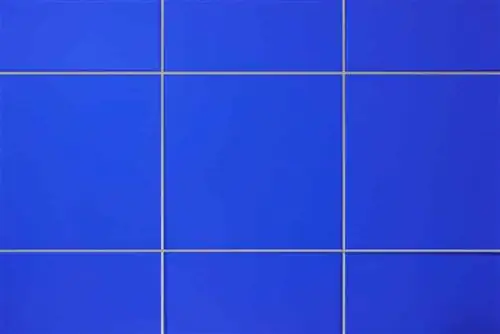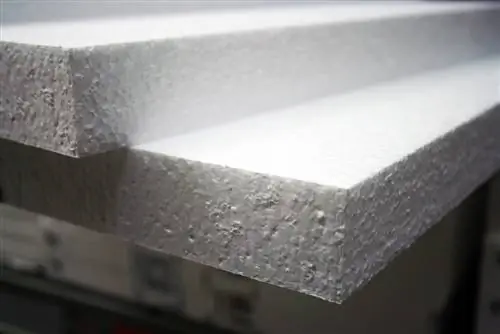- Author admin [email protected].
- Public 2023-12-17 03:39.
- Last modified 2025-01-24 12:45.
Yellow and dry patches in the lawn are not only unsightly, they can also damage the entire lawn over time if not addressed. Because the felt in the lawn can suffocate the entire area. If the thatch thickens over time, nutrients and water are no longer passed on to the roots. If this has happened and some areas have become matted, first aid should be provided quickly.
Why thatch needs to be removed
If thatch is not de alt with in a timely manner, it can suffocate the entire lawn in a short time. If the felt thickens, air is removed from the soil, preventing the penetration of nutrients and the absorption of water. In addition, the lawn thatch not only damages the plants themselves but also the entire soil surface. Even after removal, only sparse growth can often be seen here. In addition, thick and moist lawn thatch is well suited to promote bacteria, pathogens and harmful insects. Thatch is a layer of dead roots, dead grass and other substances. These accumulate in the grass over time. Lawn thatch is not unusual, but it should be removed from just one spot immediately after it is discovered and prevented in the future. You can combat thatch in the following ways:
- picking out by hand
- demossing
- scarify
- aerify
- besanden
- sow new
- fertilize
- prevent
Tip:
As a rule, it is always helpful if you prevent thatch every year and don't give it a chance. Because it can take a very long time and many work steps are necessary to get the felt out of the lawn and until the area becomes nice and juicy green again without any yellow spots.
Plucking by hand
If there are only a few spots in the lawn and the area is relatively small, then the thatch can be plucked out by hand and a hand rake. At the same time, the now bare area can be further worked on by mixing in sand, sowing new seeds and fertilizing at the same time. In such a case, lengthy removal of moss or scarification is not necessary.
Tip:
If it's just small, broken areas in the lawn, you can also cut off pieces from the edge or in a corner that cannot be seen and use them on the bare areas. This is quicker than sowing seeds.
Demossing
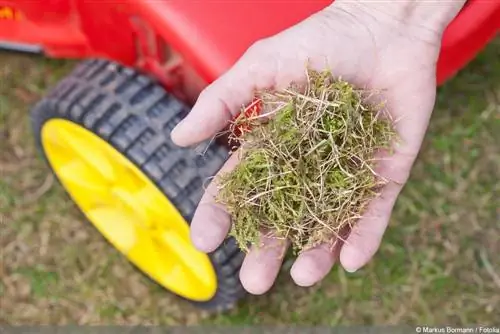
If the felt layer is still quite thin and there are only a few areas in the lawn, then it is usually enough to use a moss remover. This is a device similar to the scarifier. Two-in-one devices are often also offered. However, the moss remover should not only be used to treat the individual matted areas, but also the entire lawn area. This work should be carried out regularly in autumn and spring. If matted areas become visible in the summer, action should be taken immediately. The following devices can help:
- Lawn harrow / moss remover
- can be attached to sit-on lawnmower
- several spring tines work on the lawn area
- Matting is removed
- Floor ventilated
- Mosser for mechanical use
- is pulled across the ground with a long pole
Tip:
Overall, the moss remover works a little more gently than the scarifier. In the latter case, it often happens that the turf is damaged and areas that are actually untouched by the thatch could be damaged.
Verticutting
Dethatching is very similar to removing moss. Here, too, a device is driven over the lawn to remove old grass and roots and to aerate the soil. The scarifier is helpful if there are already more patches of thatch on the area, but also as a preventive measure. Scarifying should also be carried out twice a year, once in spring and once in autumn. In addition to scarifiers that are operated by hand, which can be very strenuous work, there are also combination devices with lawn mowers. The procedure is as follows:
- Mowing the lawn
- set the scarifying function at the same time
- Mower loosens soil at the same time
- the entire area is well ventilated
- Pull the hand scarifier over affected areas
- in spring and autumn over the entire area
Tip:
If you have a larger lawn, then it is definitely worth purchasing a lawn mower with a simultaneous scarifying function. Because working with a hand scarifier can be very strenuous on larger areas.
Aerification
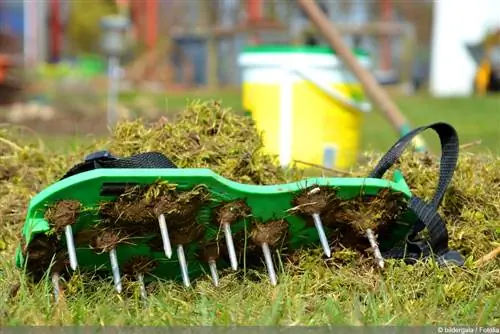
Aerating should allow air and therefore oxygen to get into the lawn. This means that the roots can absorb water and nutrients better, the grass can thrive better and matting can be prevented. You should proceed as follows when aerating:
- Prick small lawn area with digging fork
- alternatively, lawn aerator shoes from specialist retailers
- simply walk along the lawn
- Lawn fan with petrol or electric motor
- suitable for very large areas
- ventilation goes deeper
- the soil under the lawn is loosened
- Water can seep away better
Tip:
All of the electrical or petrol-powered devices mentioned here can also be borrowed from specialist retailers for one or more days if the purchase is too expensive for you or you do not have a place to park the machines.
Besanden
A matted lawn usually occurs when the soil is too compacted. With the steps described above, the matted areas in the lawn can be easily removed, but unsightly holes remain in the lawn because the grass no longer grows back on its own. Therefore, the next step after removing moss or scarifying and aerating should be sanding. The procedure is as follows:
- only edit the damaged areas
- Pricking holes with a digging fork
- Drive the tines completely into the ground
- Shake holes wider
- this is how channels can form
- should remain permanent
- fill in fine-grained sand
- this is how the earth becomes loose again
Note:
If you poke holes in the turf on a lawn that has not yet been damaged, you must proceed more carefully so that no roots are injured and no damage occurs.
Sow new
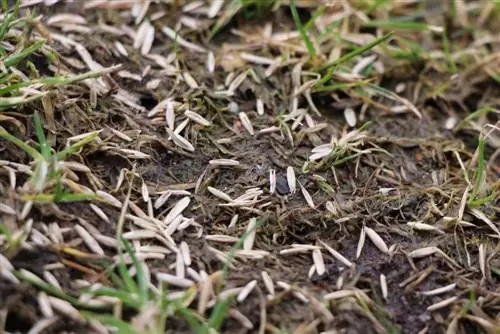
No new lawn will grow on its own in areas that have been damaged by felt and have already been worked on, even if this misconception is still widely circulating. Because here the roots have also been torn away, there is no longer any basis for growth. Therefore, new lawn must be sown here. The following should also be taken into account:
- There are big differences in lawn seeds
- always choose the same lawn that is already growing
- usually sow in spring
- in acute cases also in summer
- Distribute lawn seeds generously
- possibly stretch nets
- so birds don't get to the seeds
- always water well
- do not enter the first few weeks
- Stalks must first have grown strongly
Note:
In contrast to a matted lawn, you still have the option of working with a lot of water and a little fertilizer if there are dry areas on the lawn. As a rule, the roots have not been damaged to such an extent and the dried out areas turn green again.
Fertilize
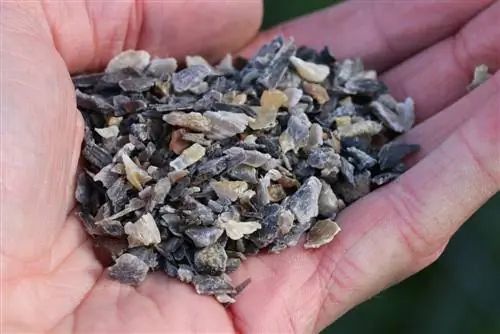
Fertilization should also be carried out at the same time as sowing. If the bare areas have been loosened up with sand, compost and horn shavings can also be added in the spring. Otherwise, a slow-release fertilizer is spread at the same time as sowing. This should not only be scattered on the sown areas but over the entire lawn. When fertilizing lawns, the following times and the fertilizers to be used should be taken into account:
- promote growth in spring and summer
- Fertilizer with nitrogen, phosphorus, magnesium, potassium
- don't do without nitrogen in spring
- fertilize in spring between March and April
- in summer only if the lawn is damaged
- lime to prevent renewed matting
- Lime prevents moss formation
- Strengthening lawns for winter in autumn
- do not use nitrogen
- Potassium strengthens the lawn for the winter
Note:
Fertilize your lawn with nitrogen in autumn, then it will get another growth spurt, which is not necessary at this time of year and can also be harmful.
Prevention
Preventing matted lawns is always better than having to repair the damage. Prevention is nothing other than proper lawn care. Because a well-maintained lawn doesn't have the chance to become matted. However, regular lawn mowing alone does not help. Therefore, the lawn should be cared for annually as follows:
- Use a lawnmower with a scarifier at the same time
- scarify twice a year
- once right after winter
- cutting the lawn for the first time
- once in autumn when the lawn was last cut
- so the lawn is well ventilated
- fertilize regularly in spring and autumn
- aerate lawns every few years
- don't leave grass clippings lying around
- Additionally promotes matting
Note:
When fertilizing, you need to pay attention to the composition, which should look different in autumn than in spring. Because in autumn it's about strengthening the lawn for the winter, in spring it's about supporting growth.

